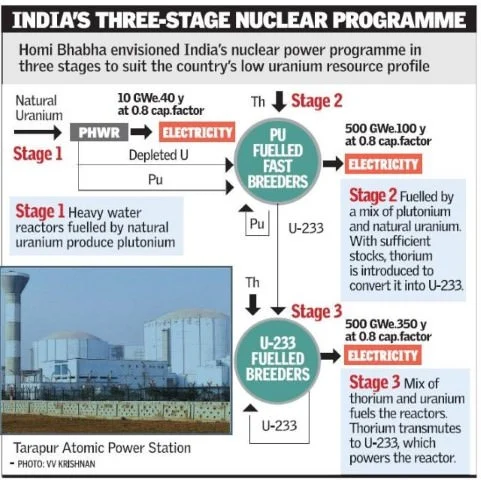Understanding India’s Nuclear Programme :

Prototype Fast Breeder Reactor (PFBR) Milestone:
Prime Minister Narendra Modi witnessed the initiation of core-loading for the indigenous PFBR, marking the start of stage II of India’s nuclear power programme.
PFBR Functionality:
The PFBR produces more nuclear fuel than it consumes, utilizing plutonium-239 (Pu239) and uranium-238 (U-238) to generate energy and produce more Pu-239, essential for India’s nuclear energy self-sufficiency.
Delays and Challenges:
The PFBR project faced delays due to technical difficulties, cost overruns, and procurement issues, leading to extended deadlines and increased costs.
PFBR Operation:
The PFBR operates as a fast breeder reactor, utilizing liquid sodium coolant in two circuits to produce electricity. However, challenges in implementation have been noted, including longer-than-expected preheating times.
Role of Small Modular Reactors (SMRs):
SMRs offer potential solutions to nuclear energy challenges, with lower costs, enhanced safety features, and the ability to use low-enriched uranium, necessitating legal and regulatory amendments for their widespread adoption.
Value of Stage II:
Stage II of India’s nuclear programme involves the construction of additional fast breeder reactors to meet energy demands, but challenges such as public perception, regulatory oversight, and nuclear waste management persist.
Future Outlook: Despite challenges, India aims to commission nuclear power reactors annually from 2024 onwards, driven by the need to decarbonize and reduce reliance on fossil fuels while addressing safety and regulatory concerns.
What is an FBR?
A Fast Breeder Reactor (FBR) is a specific type of nuclear reactor utilizing fast neutrons to induce the fission of uranium-238, unlike conventional reactors that employ slow neutrons. The term “breeder” denotes the reactor’s capability to generate more fissile
material than it consumes.
The FBR constitutes a crucial component of India’s three-stage nuclear power programme, being the sole reactor of its kind globally with the capacity to reprocess both carbide and oxide fuels discharged from fast reactors.
PM witnesses the historic “Commencement of Core Loading” at India’s first indigenous Fast Breeder Reactor (500 MWe) at Kalpakkam, Tamil Nadu
Addressing Undertrial Incarceration in India: A Complex Dilemma:
Introduction: The Growing Concerns Over Bail Denials
– Chief Justice of India highlights a growing reluctance among trial judges to grant bail.
– Majority of India’s prison population comprises undertrials, leading to overcrowding in
prisons.
Recognizing the Bail System’s Failings: Supreme Court Intervention
– Supreme Court acknowledges bail system’s ineffectiveness, calls for comprehensive guidelines.
– Despite guidelines, bail law’s principles remain largely unobserved.
Understanding the Underlying Issues: Lack of Empirical Evidence
– Reimagining bail law requires understanding the root causes of undertrial incarceration.
– Lack of empirical data on bail application rates, acceptance, rejection, and compliance hampers effective reform.
Challenges in Safeguard Enforcement: Exclusionary Nature
– Safeguards against arbitrary arrest often exclude marginalized individuals.
– Arrest justifications disproportionately affect migrants, asset-less individuals, and those with no family contact.
Judicial Discretion and Bail Adjudication: A Vague Landscape
– Courts exercise discretion in bail decisions based on offense severity and accused’s character.
– Lack of recorded reasons for bail denials and unclear rationale in considering bail factors.
Challenges in Bail Compliance: Structural Barriers
– Many undertrials remain in prison due to difficulties in meeting bail conditions.
– Compliance challenges include lack of means, residence, identity proof, and family support.
Flawed Assumptions in Bail System: Counterproductive Presumptions
– Bail system assumes access to property and social connections, undermining ‘bail not jail’ principle.
– Urgent need for bail reform grounded in comprehensive problem diagnosis.
Conclusion: Urgent Need for Bail Reform
– Current bail system perpetuates undertrial incarceration, necessitating comprehensive reform.
– Empirical understanding, safeguard enforcement, judicial discretion, and compliance challenges must inform reform efforts.
